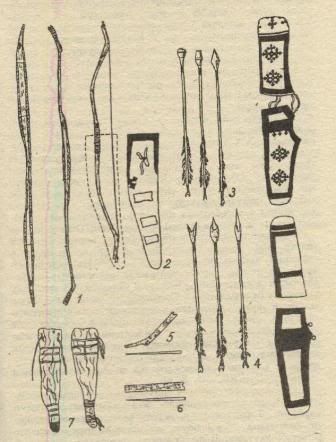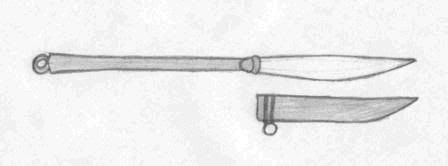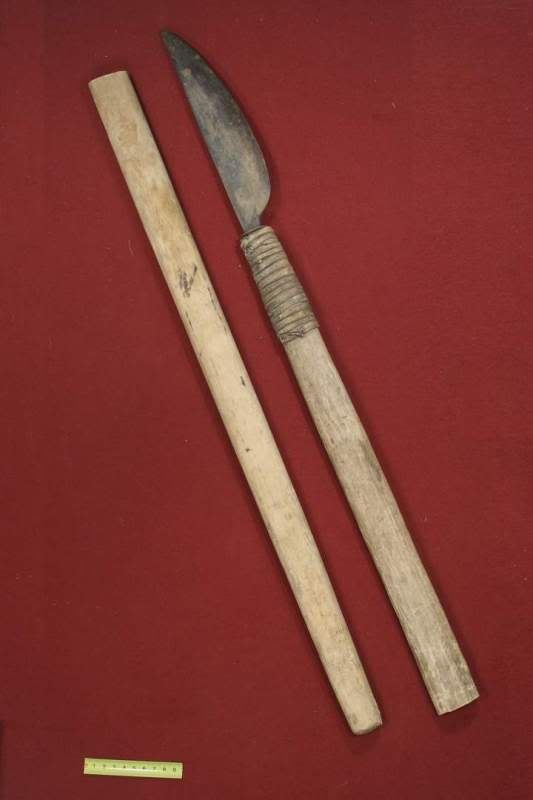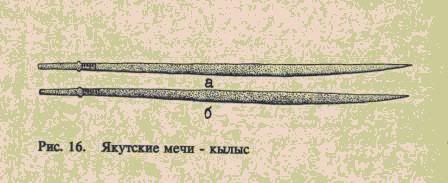|
|
Post by H. İhsan Erkoç on Apr 19, 2012 9:48:14 GMT 3
Nice maps aca  |
|
|
|
Post by aca on Apr 19, 2012 13:14:36 GMT 3
I'm planing to post an article about Yakut weapon used in XVII century. The weapon called "palma" in the west actually is called "batas" in Yakut, and it has a few variations. I'll post the article as soon as I find some free time.
|
|
|
|
Post by H. İhsan Erkoç on Apr 20, 2012 11:18:08 GMT 3
Looking forward to it.
|
|
|
|
Post by aca on Apr 22, 2012 8:22:39 GMT 3
YAKUT WEAPON Okh-saa (Ох-саа) - Bow and Arrow  Yakut bow was the best in Siberia, and was actually derived from XV century Mongol (Buryat) bow. That tells us a lot about the time of Yakut arrival on the middle Lena region. Batas (Батас)  A type of large Palma, Batas is a close combat weapon. It's blade was 50-70 cm long, with the handle 1,5 m long. Batiya (Батыйа)   Palma. Close combat weapon for cutting and sabbing. Blade 30 cm, handle 80 cm Khotokoon (Хотокоон)  The smallest type of palma. It's dimensions depended on the blacksmiths who made it. Kylys (Кылыс) - Sword  Remains of some Yakut swords. Üngüü (үҥүү) - Spear  Yakut spears Duulagha bergehe (Дулаҕа бэргэhэ) - Helmet   |
|
|
|
Post by H. İhsan Erkoç on Apr 23, 2012 13:43:24 GMT 3
Very nice  |
|
|
|
Post by aynur on Apr 23, 2012 16:43:07 GMT 3
Those are some really good pictures. It brings out the unique pattern of nomadic warfare and combines it with the harsh conditions of the Siberian north. The Sakha must have been tough warriors.
|
|
|
|
Post by aca on Apr 23, 2012 22:06:07 GMT 3
They certainly were good warriors. Constant Tungus raids and endless bloody wars between their own clans made them cruel and even savage. There was a custom among Yakuts to throw embers at children to make them practice their agility.
Actually, Yakuts were not a nomadic people. They lived in a wooden houses (balaghan) during winter, and in large conical tents (uraha) during summer. But they never migrated from summer to winter pastures like nomads of the Steppe. Instead they lived in one place, usually an "alaas" (large meadow surrounded by forest, and with a lake in the middle), letting their cattle graze freely during summer (while they were preparing hay for the winter). During long winter months their cattle was safe in a type of stables (khoton) and fed with hay. Even if some Yakut families used to move from one place to another, that couldn't be too far, because each Yakut clan occupied only a small territory. In XVII century the most powerful clans were Khangalas, Nam, Menge, Boroghon, Bootur Uus, Boro Botung and Khoro, each numbering about 2000-5000 people. Also there ware about 30 smaller clans numbering less than 1000 people each. The most powerful of all was the Khangalas clan, which could raise a total number of about 600 warriors for the attack on Yakutsk fortress.
|
|
|
|
Post by aca on May 11, 2012 11:26:22 GMT 3
Yakut song from the film "Тыал баарын тухары" (While there is wind). Nice rock song for a beautiful story. Also pay attention to XVIII Sakha costumes www.youtube.com/watch?v=qO7Zg5u_9aE |
|
|
|
Post by siberiancoldbreeze on May 11, 2012 20:10:35 GMT 3
wow..just wow thank you Aca, I got one more favorite band  |
|
|
|
Post by aca on May 12, 2012 10:13:09 GMT 3
You're welcome  |
|
|
|
Post by H. İhsan Erkoç on May 12, 2012 14:52:08 GMT 3
Nice song indeed.
|
|
|
|
Post by westscythian on Jun 16, 2012 6:45:23 GMT 3
Yakuts and Dolgans are both northern Turkic people. Most of them Y-DNA haplogroup N1c1, which is modal among Siberians and Finno-Ugric populations.
|
|
|
|
Post by missun on Dec 29, 2015 18:11:26 GMT 3
From what book is Okh-saa?
|
|
|
|
Post by aca on Jan 2, 2016 11:54:15 GMT 3
|
|
|
|
Post by steppeson on Feb 1, 2016 7:17:59 GMT 3
Thank you for posting all these posts about the Sakha, Dolgans and others, all very informative and interesting. Delving into my DNA test results, the Siberian cluster frequently pops up with Ulchi, Sakha, Nganasan and Yukagir showing significance. Just love reading more about these groups that I knew nothing about previously.
|
|